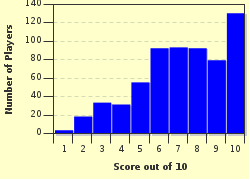Quiz Answer Key and Fun Facts
1. One of the earliest Irish leaders was Daniel O'Connell. He provided virtually full civil and political rights to Irish Catholics through the 1829 Catholic Emancipation Act. What name was given to the speeches O'Connell gave to huge crowds in order to gain the support needed to pass this Act?
2. Daniel O'Connell set out over the next few years to encourage Irish Catholics into high positions in society, thus exercising the rights achieved in the Catholic Emancipation Act. His popularity and achievements led to him gaining which nickname?
3. Following O'Connell, more radical organisations emerged. What group, which attempted an uprising in 1848, included members such as Thomas Davis and Smith O'Brien?
4. Charles Stewart Parnell was another key figure in 19th century Irish history. He aimed to increase the control that Irish farmers had over their land they worked on. Which man, a Fenian, suggested that Parnell should become involved in what became known as the "Land War"?
5. The leader Isaac Butt began to forward the idea of Irish political independence, and this was developed by Parnell. What name was given to the organisation set up to achieve an Irish parliament with control over Irish affairs?
6. Another key figure in the progression of the fight for Irish independence was not an Irish radical, but a British politician. Which man, who was Prime Minister four times, had thrown his weight behind Home Rule by the end of the 19th century?
7. The Easter Rising of 1916 was an attempt by Irish radicals, such as James Connolly, to end British rule over Ireland. Patrick Pearse saw the rising as a "blood sacrifice", a way of getting a reaction. In which city did the Easter Rising occur?
8. Following the more radical outlook on Irish independence after the 1916 Easter Rising, political parties such as Sinn Fein increased in popularity. What was the name of the man who became the leader of Sinn Fein shortly after the Easter Rising?
9. Often denounced as a "tiny murder gang", which group, headed by Michael Collins, used terror tactics throughout the 20th century to demand independence?
10. The 1921 Anglo-Irish Treaty offered "dominion status", a clear improvement on Home Rule. Many accepted it with open arms, but some (including de Valera) did not believe it went far enough. What factor was the main problem with the treaty?
Source: Author
doublemm
This quiz was reviewed by FunTrivia editor
bloomsby before going online.
Any errors found in FunTrivia content are routinely corrected through our feedback system.
